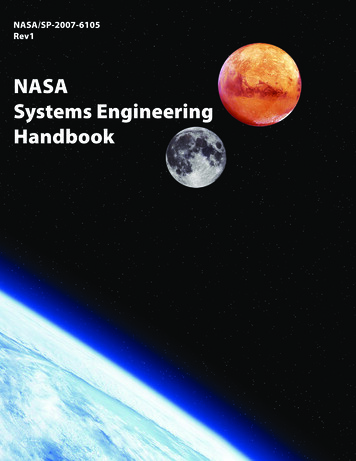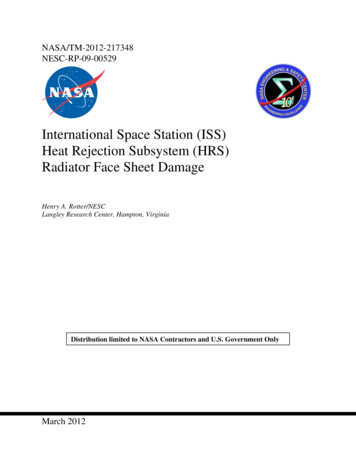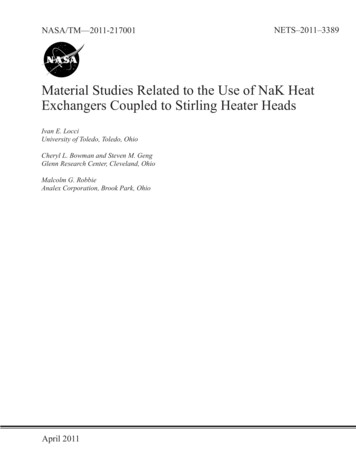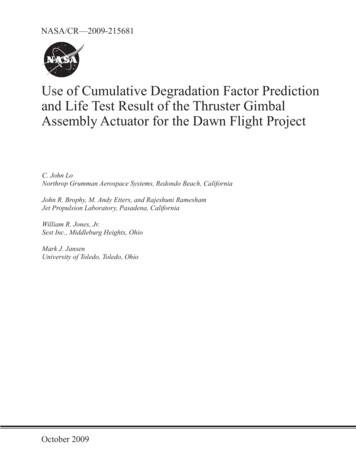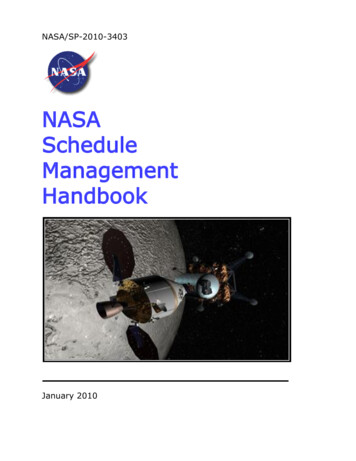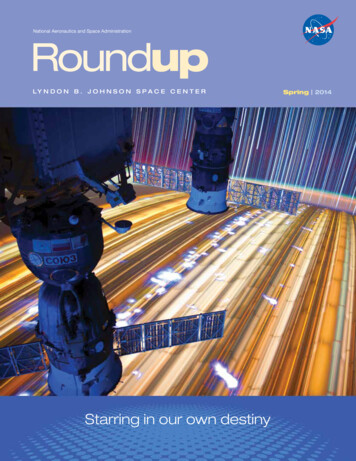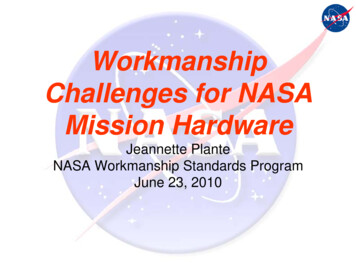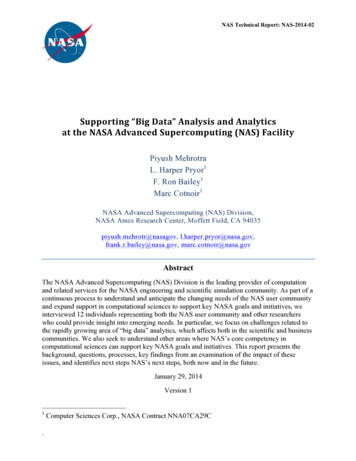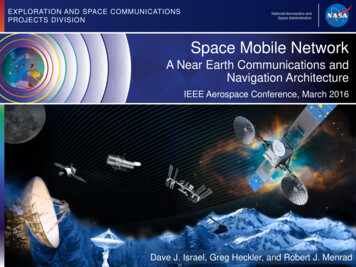
Transcription
EXPLORATION AND SPACE COMMUNICATIONSPROJECTS DIVISIONSpace Mobile NetworkA Near Earth Communications andNavigation ArchitectureIEEE Aerospace Conference, March 2016Dave J. Israel, Greg Heckler, and Robert J. MenradNASA GODDARD SPACE FLIGHT CENT ER
Introduction NASA’s Space Communications and Navigations (SCaN) Program is responsiblefor all NASA space communication and navigation activities.– Deep Space Network (DSN)– Near Earth Network (NEN)– Space Network (SN) SCaN chartered the Earth Regimes Network Evolution Study (ERNESt), whichwas completed in May 2015.– NASA’s Goddard Space Flight Center (GSFC) led study to create a next generation nearEarth space communications and navigation architecture for 2025 and beyond.– Goals: Provide communication and navigation services to missions within 2M kilometers of the Earth (justbeyond the Earth-Sun L2 point).Customizable and scalableInclude industry and international partnersAdvance new science and technologiesReduce commoditized costs.The resulting ERNESt architectural framework was named the “Space Mobile Network (SMN),” to accentuatethe focus on the user experience with analogies to the terrestrial mobile wireless smartphone user experience.E X P L O R AT I O N A N D S P A C E C O M M U N I C AT I O N S P R O J E C T S D I V I S I O NN A S A G O D D A R D S PA C E F L I G H T C E N T E R
Comparing the Space Mobile Network toTerrestrial Wireless Communications SystemsTerrestrial WirelessCommunication SystemsSpace Mobile Network(SMN)Ability to connect to and access others connected to the samenetwork at anytimeThe user experience should be the same as today’s Internet cloudexperience where a user knows that once they connect themselves to“the cloud,” services, sources, and destinations are availableCurrent position knowledgeNext Generation Broadcast Service (NGBS) to provide a continuouslyavailable global coverage and navigation beacon data signal.Hand-held computing powerWill minimize user burden including the Size, Weight, and Power(SWaP) required for the flight systems.Activities are not constrained by having to meet at a pre-determinedtime and location.User Initiated Services (UIS) will allow customers to receive servicewithout a priori scheduling ahead. (expanding ops concepts)Expectation of full bandwidth end-to-end communications wheneverthey have a connection – live video on demand, for example.Has more implementation flexibility while still meeting userrequirements. Will ensure that the user’s data volume is delivered tothe desired destination in the science driver case or delivered off ofthe user platform in the onboard storage limitation case within alatency requirement.E X P L O R AT I O N A N D S P A C E C O M M U N I C AT I O N S P R O J E C T S D I V I S I O NN A S A G O D D A R D S PA C E F L I G H T C E N T E R
Dynamic End-To-End Data Path Most spacecraft users operate with the knowledgethat a link is not always available and thereby, storetheir data onboard, and transmit the data based ona latency requirement. A mission that needs to offload data in order to freeup onboard storage or meet some other operationalconstraint is only really concerned with the speed ofthe space link from their spacecraft to thecommunications asset. (“Get this data off myplatform”) A mission with science data delivery timelinessrequirements, such as one that updates hurricaneforecasts for example, will be concerned about theeffective data rate between the user platform anddata destination (i.e. an end-to-end path). (“Get thisdata to its destination”)The significant difference between terrestrial communicationsnetworks and the Space Mobile Network is the specification ofdata volume delivery instead of the specification of data rates.E X P L O R AT I O N A N D S P A C E C O M M U N I C AT I O N S P R O J E C T S D I V I S I O NN A S A G O D D A R D S PA C E F L I G H T C E N T E R
Link TypesContinuously Available Low Rate Links The current NASA Space Network is able to provide continuous low rate return links via the TDRSSMultiple Access (MA) system. The SMN will provide links that are continuously available and minimize required user transmit power andrelated user burden– The availability requirement likely drives the solution to space-based relays, which in turn leads to arequirement for low relay payload SWaP.– The ERNESt team identified candidate technology solutions including Optical MA, Ka-Band MA, andenhanced S-Band MA.High Rate Forward and Return Links Unlike Low Data Rate links, High Data Rate links will likely have reduced availability LEO mission direct to Earth downlinks may be achieved at much higher data rates, but the total viewperiods to ground stations would be less than the view periods to a GEO relay constellation. These links may be either RF or optical links, space based relay or direct to EarthThe data rates and physical characteristics of these links will evolve based on trades to optimize theavailability and or link performanceE X P L O R AT I O N A N D S P A C E C O M M U N I C AT I O N S P R O J E C T S D I V I S I O NN A S A G O D D A R D S PA C E F L I G H T C E N T E R
User Initiated ServicesLow RateForward LinkLow Rate Return Link When the spacecraft requires services, such as a high data ratelink, it transmits a request to the network over the low rate link. The network determines the next available opportunity tosupport the mission and responds to the request with the timeand information required for the mission to access the service. When the service time arrives, the mission receives therequested service. The requested service could be provided by a space relay orground station from any compatible and participating provider(NASA, commercial, international, etc.). The system would still support scheduled services as today, butit would support the larger percentage of users on thecontinuously available and UIS scheduled services, allowing thenetwork to be more responsive and efficient. The implementation of UIS requires a protocol for a user tonegotiate a service request, either over a space link orterrestrially. The likelihood of receiving the desired service and guaranteedmaximum wait time would have to be within user expectationsHigh Rate LinkSMN Provides Continuously Available Forwardand Return Links and Enables Users toSchedule High Data Rate Forward and ReturnLinks through User Initiated Services (UIS), arevolution in mission execution.E X P L O R AT I O N A N D S P A C E C O M M U N I C AT I O N S P R O J E C T S D I V I S I O NN A S A G O D D A R D S PA C E F L I G H T C E N T E R
Dynamic Link Allocation and Scheduling The UIS will also require ascheduling system capableof dynamically fielding therequests: comparing themagainst availableresources, schedules, andpriorities. The system must alsoprovide a way to dispatchthe now scheduled servicedetails to the user systemsand provider elements Services can be providedby a combination ofproviders and schedulingsystemsIn the case of today’s terrestrial mobile network user, there are no apparent scheduling activities required forthe user to get the desired service. The user pulls out their device and dials, enters a website address, or, asis becoming more prevalent, the mobile device is continuously requesting, receiving, and transmitting datawithout any required user action. Though there is no apparent scheduling, the network is still constantlyallocating bandwidth and other resources to meet all of the performance requirements.E X P L O R AT I O N A N D S P A C E C O M M U N I C AT I O N S P R O J E C T S D I V I S I O NN A S A G O D D A R D S PA C E F L I G H T C E N T E R
Disruption/Delay Tolerant Network It is typical that the user is not requesting service to deliver data immediately to the finaldestination but rather requesting service to offload the onboard storage. A Disruption/Delay Tolerant Network (DTN) allows additional flexibility in the implementation,allocation, and scheduling of the end-to-end path. DTN protocols have been demonstrated to provide the store-and-forward network capabilitiesto support the automated data buffering, routing, and quality of service required to provide thisdynamic end-to-end path data distribution DTN-enabled provider node will permit a user to offload their data at whatever rate their spacelink allows, while still allowing the provider flexibility to optimally implement, allocate, andschedule all the nodes and links along the rest of the end-to-end path. In the near-earth environment, it is also expected that some scenarios can be supported usingIP for the network layer services. Support of DTN and IP within the architecture are notmutually exclusive.Trades need to be done to determine the amount of processing, storage, and network functionality toinclude on a space relay node, as opposed to performing these functions in ground-based systems.E X P L O R AT I O N A N D S P A C E C O M M U N I C AT I O N S P R O J E C T S D I V I S I O NN A S A G O D D A R D S PA C E F L I G H T C E N T E R
Next Generation Broadcast Service(NGBS) The Next Generation Broadcast Service (NGBS) is currently under development to demonstrate aMultiple Access Forward link beacon signal design that can be implemented to provide radiometricsor optimetrics for onboard navigation, a path for UIS data, and individual mission data. In many cases, knowledge of the relay location will be necessary for the user to radiate a UISrequest. This link will provide orbital data; which, in combination with the user’s autonav capability will therequest to be radiated in the proper direction.The Next Generation Broadcast Service(NGBS), formally known as the TDRSSAugmentation Service for Satellites (TASS), willdemonstrate a forward beacon that can beutilized for the sending and receiving of criticalUIS communications, individual mission data,and radiometrics or optimetrics for onboardnavigation.E X P L O R AT I O N A N D S P A C E C O M M U N I C AT I O N S P R O J E C T S D I V I S I O NN A S A G O D D A R D S PA C E F L I G H T C E N T E R
Transition Strategy SMN architectural framework and operationsconcepts can begin to be implemented beforeany new space relay nodes or ground stationantennas are deployed(as proposed in the ERNESt study) The RF bent-pipe design of the TDRSSsatellites allows new services to beimplemented at ground station locations toprovide full orbital coverage. Thoughtheperformanceofinitialdemonstrations may be limited to lower datarates or longer latency than desired, benefits,therequirements and the challenges of the futuresystems. TASS and the already existing DemandAccess System (DAS) can be used for thespace link communications channels for thefirst instantiations of UIS clients and serverstied into the TDRSS scheduling system. Thedemonstration can be expanded to tie into theNear Earth Network scheduling system todemonstrate the provider peering ops concept.E X P L O R AT I O N A N D S P A C E C O M M U N I C AT I O N S P R O J E C T S D I V I S I O NN A S A G O D D A R D S PA C E F L I G H T C E N T E R
Conclusions The Space Mobile Network architecture produced bythe ERNESt team has identified architectural featuresand a transition strategy. SMN focuses on moving the space communicationsand navigation user experience closer to the terrestrialmobile network user experience NASA SCaN continues to validate and refine the nextgeneration architecture, to develop the associatedtechnology, and to implement the first demonstrationsand early operational capabilities.E X P L O R AT I O N A N D S P A C E C O M M U N I C AT I O N S P R O J E C T S D I V I S I O NN A S A G O D D A R D S PA C E F L I G H T C E N T E R
References “Earth Regimes Network Evolution Study,” NASA. 1 May 2015. Israel, David J., Bernard L. Edwards, Keith E. Wilson, and John D.Moores. "An Optical Communications Pathfinder for the Next GenerationTracking and Data Relay Satellite." SpaceOps 2014, Pasadena, CA. 2014. Israel, David J., Donald M. Cornwell, Gregory D. Menke, W. JohnGuineau, "Demonstration of Disruption Tolerant Networking across LunarOptical Communications Links.” AIAA Space 2014, San Diego, CA. 2014. “NGMN 5G White Paper,” NGMN Alliance. 17 February 2015. “Operations Concept for a Solar System Internetwork (SSI)”, InteragencyOperations Advisory Group Report, October 2010. “Optical Link Study Group Final Report,” IOAG.T.OLSG.2012. 5 June2012.E X P L O R AT I O N A N D S P A C E C O M M U N I C AT I O N S P R O J E C T S D I V I S I O NN A S A G O D D A R D S PA C E F L I G H T C E N T E R
AcronymsC&N - Communication and NavigationDSN - Deep Space NetworkDTN - Disruption/Delay Tolerant NetworkERNESt - Earth Regimes Network Evolution StudyESC - Exploration and Space CommunicationsGEO - Geosynchronous OrbitGSFC - Goddard Space Flight CenterLEO - Low Earth ObitMA - Multiple AccessNASA - National Aeronautics and Space AdministrationNEN - Near Earth NetworkNGBS - Next Generation Broadcast ServiceRF - Radio FrequencySCaN - Space Communications and NavigationsSMN - Space Mobile NetworkSN - Space NetworkSWaP - Size, Weight, and PowerTASS - TDRSS Augmentation Service for Satellites ServiceTDRSS - Tracking and Data Relay Satellite SystemUIS - User Initiated ServicesE X P L O R AT I O N A N D S P A C E C O M M U N I C AT I O N S P R O J E C T S D I V I S I O NN A S A G O D D A R D S PA C E F L I G H T C E N T E R
EXPLORATION AND SPACE COMMUNICATIONSPROJECTS DIVISIONMISSIONAs a national resource, the Exploration and SpaceACKNOWLEDGEMENTSCommunications (ESC) Projects Division enablesThe authors thank SCaN, thescientific discovery and space exploration byERNESt team and CarolynCrichton, for helping to makeproviding innovative and mission-effective spacethis presentation possible.communications and navigation solutions to thelargest community of diverse YCONNECTED:Bob Menrad, Associate DirectorCathy Barclay, Deputy Program Manager/ExecutionMark Brumsfield, Deputy Program Manager/ImplementationDave Israel, ESC ArchitectTracy Felton, Program Business ManagerMike Weiss, Associate Program ManagerDavid c.gsfc.nasa.gov/ Facebook: @NASA.ESC, @NASA.TDRS, @NASASCaN, Twitter: @NASA TDRS,@NASALaserCommNASA GODDARD SPACE FLIGHT CENT ER
NASA’s Space Communications and Navigations (SCaN) Program is responsible for all NASA space communication and navigation activities. – Deep Space Network (DSN) – Near Earth Network (NEN) – Space Network (SN) SCaN chartered the Earth Regimes Network E

